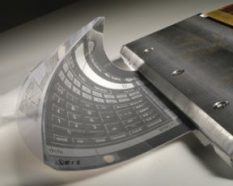Roll-Up Computer Monitors to Go
Future electronic displays may be paper-thin and as flexible as a stick of gum.
Have you noticed how gadgets are getting smaller? Cell phones, laptops, MP3 players—they’re all getting slimmer and lighter.
Now, researchers at the companies Philips and E Ink have taken another step toward greater convenience. It’s a new type of electronic paper that displays words and pictures, just like your computer monitor. But it’s as thin as a sheet of regular paper. You can roll it up, fold it, or bend it. If you drop it, don’t worry. It won’t break.
 |
|
Future electronic displays could look and feel more like paper. |
| Polymer Vision/Philips |
The electronic paper has two main layers. The top layer is a plastic film that has tiny bubbles containing two types of ink, black and white. The bottom layer contains a network of tiny electronic circuits. These circuits are made out of a special type of plastic that conducts electricity.
How do these two layers work together to display a picture or words? First, the black and white inks have opposite electrical charges. When a particular voltage is applied to a bubble, the white ink rises to the top and the black ink sinks to the bottom, where you can’t see it. And if a different voltage is applied, the opposite happens. The black ink rises while the white ink lays low.
Applying different voltages by way of the circuitry below the ink layer organizes the ink into various patterns, such as words and pictures. By switching the voltage pattern, the electronic-paper display can change a few times per second.
The scientists who developed the electronic paper claim that their version is the thinnest, most flexible yet. Previous versions of electronic paper were made with a thin sheet of glass, which was fragile and rigid.
Bas Van Rens at Philips in the Netherlands says that, within a couple of years, you could be using electronic paper to check your e-mail or to surf the Internet. When you’re finished, you’d roll up your sheet of e-paper and tuck it away in your back pocket.—S. McDonagh
Going Deeper:
Goho, Alexandra. 2004. Flexible e-paper: Plastic circuits drive paperlike displays. Science News 165(Jan. 31):67. Available at http://www.sciencenews.org/20040131/fob1.asp .
Sohn, Emily. 2003. Electronic paper turns a page. Science News for Kids (Dec. 3). Available at http://www.sciencenewsforkids.org/articles/20031203/Feature1.asp .
Sohn, Emily. 2003. Opening a window on video paper. Science News for Kids (Oct. 1). Available at http://www.sciencenewsforkids.org/articles/20031001/Note2.asp .
You can learn more about electronic paper and ink at computer.howstuffworks.com/e-ink.htm (How Stuff Works) and www.media.mit.edu/micromedia/elecpaper.html (MIT Media Laboratory).







